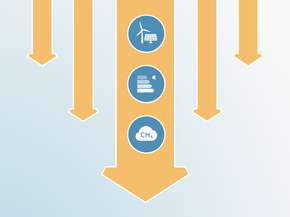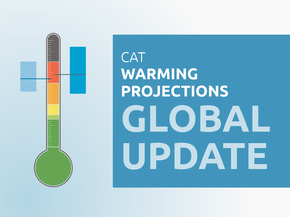Critically Insufficient4°C+
World
NDCs with this rating fall well outside of a country’s “fair share” range and are not at all consistent with holding warming to below 2°C let alone with the Paris Agreement’s stronger 1.5°C limit. If all government NDCs were in this range, warming would exceed 4°C.
Highly insufficient< 4°C
World
NDCs with this rating fall outside of a country’s “fair share” range and are not at all consistent with holding warming to below 2°C let alone with the Paris Agreement’s stronger 1.5°C limit. If all government NDCs were in this range, warming would reach between 3°C and 4°C.
Insufficient< 3°C
World
NDCs with this rating are in the least stringent part of a country’s “fair share” range and not consistent with holding warming below 2°C let alone with the Paris Agreement’s stronger 1.5°C limit. If all government NDCs were in this range, warming would reach over 2°C and up to 3°C.
2°C Compatible< 2°C
World
NDCs with this rating are consistent with the 2009 Copenhagen 2°C goal and therefore fall within a country’s “fair share” range, but are not fully consistent with the Paris Agreement long term temperature goal. If all government NDCs were in this range, warming could be held below, but not well below, 2°C and still be too high to be consistent with the Paris Agreement 1.5°C limit.
1.5°C Paris Agreement Compatible< 1.5°C
World
This rating indicates that a government’s NDCs in the most stringent part of its “fair share” range: it is consistent with the Paris Agreement’s 1.5°C limit.
Role model<< 1.5°C
World
This rating indicates that a government’s NDC is more ambitious than what is considered a “fair” contribution: it is more than consistent with the Paris Agreement’s 1.5°C limit.
Sources
List of references
- APERC (2019) APEC Energy Demand and Supply Outlook – 7th edition (Vol II). Tokyo, Japan: Asia Pacific Energy Research Centre, The Institute of Energy Economics, Japan. Available at: http://aperc.ieej.or.jp/file/2010/9/24/Outlook_Volume_II_4E.pdf.
- Cheong Wa Dae (2020) Keynote speech on the Korean New Deal. 14 July 2020. In Korean. Cheong Wa Dae (President’s Office of the Republic of Korea). Available at: https://www1.president.go.kr/articles/8874 (Accessed: 14 July 2020).
- Climate Analytics (2020) Transitioning towards a zero-carbon society: science-based emissions reduction pathways for South Korea under the Paris Agreement. Berlin, Germany: Climate Analytics.
- Greenhouse Gas Inventory & Research Center of Korea (2020) 2019 National Greenhouse Gas Inventory (1990-2017) Report (NIR). Seoul, Republic of Korea.
- ICAP (2018) Republic of Korea approves 2030 GHG roadmap and 2nd phase ETS allocation plan. International Carbon Action Partnership. Available at: https://icapcarbonaction.com/ko/news-archive/567-republic-of-korea-approves-2030-ghg-roadmap-and-2nd-phase-ets-allocation-plan (Accessed: 3 November 2019).
- ICAP (2019a) ETS Detailed Information: EU Emissions Trading System (EU ETS). Last update: 29 October 2019. International Carbon Action Partnership. Available at: https://icapcarbonaction.com/en/?option=com_etsmap&task=export&format=pdf&layout=list&systems[]=43.
- ICAP (2019b) Korea Emissions Trading Scheme. Last update: 29 October 2019. International Carbon Action Partnership. Available at: https://icapcarbonaction.com/en/?option=com_etsmap&task=export&format=pdf&layout=list&systems%5B%5D=47 (Accessed: 3 November 2019).
- ICCT (2019) Passenger car CO2 emissions and fuel consumption, normalized to NEDC. Updated June 2019. International Council on Clean Transportation. Available at: https://theicct.org/sites/default/files/NEDC_CO2_car_Jun2019.pdf (Accessed: 3 November 2019).
- IEA (2018) CO2 emissions from fuel combustion (2018 edition). Paris, France.
- IEA (2019a) CO2 emissions from fuel combustion (2019 edition). Paris, France.
- IEA (2019b) Global EV Outlook 2019 - Scaling up the transition to electric mobility. Paris, France: International Energy Agency. Available at: https://www.iea.org/publications/reports/globalevoutlook2019/ [accessed on 12 June 2019].
- IEA (2019c) World Energy Balances (2019 edition). Paris, France: International Energy Agency.
- IEA (2020) Korea Balance (2017). Paris, France: IEA.
- IMF (2020) World Economic Outlook Update, June 2020. Washington, D.C., United States: IMF.
- Keramidas, K. et al. (2018) Global Energy and Climate Outlook 2018: Sectoral mitigation options towards a low-emissions economy – Global context to the EU strategy for long-term greenhouse gas emissions reduction. Luxembourg: Publications Office of the European Union. doi: 10.2760/67475.
- Korea New and Renewable Energy Center (2019) Supply Obligations (RPS). In Korean. Korea New and Renewable Energy Center. Available at: https://www.knrec.or.kr/business/rps_guide.aspx (Accessed: 3 November 2019).
- Ministry of Environment (2018) National Greenhouse Gas Reduction Target by 2030: Amended baseline roadmap roadmap for achieving achievement. Seoul, Republic of Korea: Ministry of Environment, Republic of Korea. Available at: http://energytransitionkorea.org/sites/default/files/2018-11/18.072030-온실가스-감축로드맵-수정안관계부처-합동 %281%29.pdf.
- MOTIE (2017) Announcement of the 8th Basic Electricity Supply and Demand Plan (2017-2031). Ministry of Trade, Industry and Energy Announcement 2017-611. In Korean. Ministry of Trade, Industry and Energy, Republic of Korea. Available at: http://www.motie.go.kr/motie/ne/announce2/bbs/bbsView.do?bbs_cd_n=6&biz_anc_yn_c=Y&bbs_seq_n=64603 (Accessed: 12 April 2018).
- MOTIE (2019a) 3rd Energy Master Plan (‘제3차 에너지기본계획’). In Korean. Seoul, Republic of Korea: Ministry of Trade, Energy and Industry, Republic of Korea. Available at: http://www.motie.go.kr/common/download.do?fid=bbs&bbs_cd_n=81&bbs_seq_n=161753&file_seq_n=1.
- MOTIE (2019b) Hydrogen Economy Roadmap of Korea. Seoul, Republic of Korea: Ministry of Trade, Energy and Industry, Republic of Korea. Available at: http://www.motie.go.kr/common/download.do?fid=bbs&bbs_cd_n=81&bbs_seq_n=161262&file_seq_n=2.
- National Law Information Center (2016) Green Growth Act. In Korean. Available at: http://www.law.go.kr/lsInfoP.do?lsiSeq=183314&efYd=20160601#0000 (Accessed: 3 November 2019).
- OECD (2020) Economic Outlook - EO107 - 2 Scenarios in one dataset. Paris, France: OECD.
- OICA (2019) 2018 production statistics. International Organization of Motor Vehicle Manufacturers. Available at: http://www.oica.net/category/production-statistics/2018-statistics/ (Accessed: 3 November 2019).
- Republic of Korea (2012) Korea’s Third National Communication under the United Nations Framework Convention on Climate Change. Low Carbon, Green Growth. Republic of Korea. Available at: http://unfccc.int/resource/docs/natc/kornc3.pdf.
- Republic of Korea (2015) ‘Submission by the Republic of Korea Intended Nationally Determined Contribution’, pp. 1–4. Available at: https://www4.unfccc.int/sites/submissions/INDC/Published%20Documents/Republic%20of%20Korea/1/INDC%20Submission%20by%20the%20Republic%20of%20Korea%20on%20June%2030.pdf.
- Republic of Korea (2016) Second Biennial Update Report (BUR2) of the Republic of Korea. Seoul, Republic of Korea: South Korea Ministry of Environment and Tourism. Available at: http://unfccc.int/resource/podcast/nc2/2nd_biennial_update_report_republic_of_korea_eng.pdf.
- Republic of Korea (2019) Third Biennial Update Report of the Republic of Korea under the United Nations Framework Convention on Climate Change. Seoul, Republic of Korea.
- Reuters (2019) S.Korea to close 6 older coal-fired power plants by 2021, from planned 2022. November 1, 2019. Reuters. Available at: https://www.reuters.com/article/southkorea-pollution-coal/skorea-to-close-6-older-coal-fired-power-plants-by-2021-from-planned-2022-idUSL3N27H1EI (Accessed: 12 November 2019).
- Shin, H. and Cha, S. (2020) South Korea to spend $95 billion on green projects to boost economy. 14 July. Reuters. Available at: https://www.reuters.com/article/us-southkorea-president-newdeal/south-korea-to-spend-95-billion-on-green-projects-to-boost-economy-idUSKCN24F0GA (Accessed: 14 July 2020).
- Transportpolicy.net (2019) South Korea: Light-duty: fuel economy and GHG. International Council on Clean Transportation, DieselNet. Available at: https://www.transportpolicy.net/standard/south-korea-light-duty-fuel-economy-and-ghg/ (Accessed: 3 November 2019).
- UN DESA (2019) World Population Prospects 2019. United Nations Department of Economics and Social Affairs Population Division. Available at: https://population.un.org/wpp/Download/Standard/Population/ (Accessed: 13 August 2019).
- US EPA (2019) Global non-CO2 Greenhouse Gas Emission Projections & Mitigation. Washington, DC, US.
- Webb, M. and Kim, J. (2018) Cracks in the ice for South Korean coal? The need for international engagement to support South Korea’s transition from coal. E3G, Solutions for Our Climate.
- Wood Mackenzie (2019) News release: South Korea could miss 2030 renewables target. 27 March 2019. Wood Mackenzie. Available at: https://www.woodmac.com/press-releases/south-korea-could-miss-2030-renewables-target/ (Accessed: 3 November 2019).
- Yonhap News Agency (2020) South Korea unveils draft plan to foster renewable energy. 8 May, 2020. Seoul, Republic of Korea: Yonhap News Agency. Available at: https://en.yna.co.kr/view/AEN20200508002200320 (Accessed: 20 July 2020).
Further analysis
Latest publications
Stay informed
Subscribe to our newsletter




